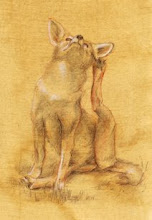
To create the final painting "Summer Meadow" I completed a full size drawing of the painting. I learn so much about my subject matter when I drawing what I will be painting. Non-artists and also many artists believe that the freer an artist works, the better the artwork. I have learned over the years that I can paint with more freedom if I have done my homework. Doing homework means being very familiar with my subject matter and with the various components of the painting.
The painting "Summer Meadow" is very complex. It has several rows of trees that are different and each type of tree has to be painted differently. The water is another complicated element in the painting. How do I show movement and reflection and water receding into the distance? And then there is the meadow! Again, I have to show detail in some areas, create a sense of distance, and suggest a vast meadow that is convincing and interesting. So, I start by carefully drawing. My "cartoon" or detailed sketch for the final painting was all done in pencil and consisted of outlines of the major areas and subjects. Because each painting is different, I sometimes render shading and shadows, but I did not need to very much shading for "Summer Meadow."
I do my final drawings on gridded drafting paper. Again this is probably different from the way many artists work. I use drafting paper because I need a large sheet that is durable and can take a lot of erasing. I like having the grid on the paper because I can make sure that horizontal and vertical elements that need to be at right angles really are at right angles to the outer edges. I prefer using transparent paper because that way I can easily position my final paper underneath when I am ready to transfer the drawing. And if I need to redraw elements, I can again reposition the original drawing over the final painting. I rarely draw directly on my watercolor paper because erasing can damage the surface of the paper. Also, having that separate sketch means that if my watercolor paper has been damaged, or if I mess up a wash, or spill coffee on my painting, I can transfer my sketch onto a new sheet and just start over!


